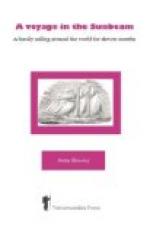NOTE.
I have to thank Mr. W. Simpson, author of ‘Meeting the Sun,’ for the passages given on pages 341 to 343 referring to the Japanese temples and their priesthood.
The vessel which has carried us so rapidly and safely round the globe claims a brief description. She was designed by Mr. St. Clare Byrne, of Liverpool and may be technically defined as a screw composite three-masted topsail-yard schooner. The engines, by Messrs. Laird, are of 70 nominal or 350 indicated horse-power, and developed a speed of 10.13 knots at the measured mile. The bunkers contain 80 tons of coal. The average daily consumption is 4 tons, and the speed 8 knots in fine weather. The principal dimensions of the hull are—length for tonnage, 157 ft.; beam extreme, 27 ft. 6 in.; displacement tonnage, 531 tons; area of midship section, 202 sq. ft.
A. B.
[Illustration: Sunset on Southampton Water.]
A VOYAGE IN THE ‘SUNBEAM’.
CHAPTER I.
Farewell to old England.
Masts, spires, and strand
receding on the right,
The glorious main expanding
on the bow.
At noon on July 1st, 1876, we said good-bye to the friends who had come to Chatham to see us off, and began the first stage of our voyage by steaming down to Sheerness, saluting our old friend the ‘Duncan,’ Admiral Chads’s flagship, and passing through a perfect fleet of craft of all kinds. There was a fresh contrary wind, and the Channel was as disagreeable as usual under the circumstances. Next afternoon we were off Hastings, where we had intended to stop and dine and meet some friends; but, unfortunately the weather was not sufficiently favourable for us to land; so we made a long tack out to sea, and, in the evening, found ourselves once more near the land, off Beachy Head. While becalmed off Brighton, we all—children included—availed ourselves of the opportunity to go overboard and have our first swim, which we thoroughly enjoyed. We had steam up before ten, and again proceeded on our course. It was very hot, and sitting under the awning turned out to be the pleasantest occupation. The contrast between the weather of the two following days was very great, and afforded a forcible illustration of the uncertainties, perhaps the fascinations, of yachting. We steamed quietly on, past the ‘Owers’ lightship, and the crowds of yachts at Ryde, and dropped anchor off Cowes at six o’clock.
On the morning of the 6th a light breeze sprang up, and enabled us to go through the Needles with sails up and funnel down, a performance of which all on board felt very proud, as many yachtsmen had pronounced it to be an impossibility for our vessel to beat out in so light a breeze.




